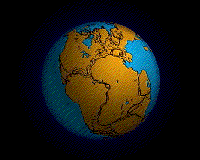Gondwana

Gondwana[1] fuit continens praehistorica, cuius partes America Australis, Antarctica, Australia, Nova Zelandia, Africa, Arabia, Madagascaria, et India sunt.
Primum Gondwana et Laurasia ortae sunt, cum Rodinia rupta esset. Haec continentes saepe "Protogondwana" et "Protolaurasia" nominantur, ut a posterioribus distinguantur. Postea in Pannotia coniunctae iterum separatae sunt, ut tertia vice in Pangaea aevo Carbonifero coniungerentur.
Pangaea aevo Iurassico rupta Tethys oceanus Gondwanam et Laurasiam separavit. Tempore Mesozoico, Gondwana in multas partes disrupta est; primo in duas. quarum occidentalis Africam, Arabiam et Americam Australem continebat, orientalis autem Indostaniam, Madagascariam, Australiam et Antarctidem. Freto Mozambicensi duae partes separatae sunt.
Abhinc 100 milliones annorum Africa ab America Australi separata est et Oceanus Atlanticus ortus est; 90 milliones India a Madagascaria et 10 milliones Australia ab Antarctide. Partes Gondwanae motae Laurasiam illiserunt et montium formationis causa fuerunt; Africae pressio Alpes creavit, Indiae autem Himalaya.
Gondwanae nomen Eduardus Suess(de) de regione Indiae excogitavit, ubi geologica huius continentis documenta inventa sunt.
Notae
[recensere | fontem recensere]- ↑ Cf. gondwanensis et gondwanicus in binominibus.
Bibliographia
[recensere | fontem recensere]- Alison Bashford, Pratik Chakrabarti, Jarrod Hore, "Towards a modern history of Gondwanaland" in Journal of the British Academy vol. 9 (2021) pp. 5–26
- Ana D. Gibbons, Joanne M. Whittaker, R. Dietmar Müller, "The breakup of East Gondwana: Assimilating constraints from Cretaceous ocean basins around India into a best-fit tectonic model" in Journal of Geophysical Research: Solid Earth vol. 118 (2013)
- Wilfried Jokat et al., "Timing and geometry of early Gondwana breakup" in Journal of Geophysical Research vol. 108 (2003)
- Andreas Mackensen, "Changing Southern Ocean palaeocirculation and effects on global climate" in Antarctic Science vol. 16 (2004) pp. 369–386
- De biogeographia
- Jason R. Ali, David W. Krause, "Late Cretaceous bioconnections between Indo-Madagascar and Antarctica: refutation of the Gunnerus Ridge causeway hypothesis" in Journal of Biogeography vol. 38 (2011) pp. 1855–1872
- V. D. Barreda et al., "Early evolution of the angiosperm clade Asteraceae in the Cretaceous of Antarctica" in Proceedings of the National Academy of Sciences of the United States of America vol. 112 (2015) pp. 10989–10994
- Annelise Frazão, Hélio Ricardo da Silva, Claudia Augusta de Moraes Russo, "The Gondwana Breakup and the History of the Atlantic and Indian Oceans Unveils Two New Clades for Early Neobatrachian Diversification" in PLoS One (30 Novembris 2015)
- José A. Jurado-Rivera et al., "Phylogenetic evidence that both ancient vicariance and dispersal have contributed to the biogeographic patterns of anchialine cave shrimps" in Nature Scientific Reports (6 Iunii 2017)
- Stephen McLoughlin, "The breakup history of Gondwana and its impact on pre-Cenozoic floristic provincialism" in Australian Journal of Botany vol. 49 (2001) pp. 271–300
- Gareth Nelson, P. Y. Ladiges, "Gondwana, vicariance biogeography and the New York School revisited" in Australian Journal of Botany vol. 49 (2001) pp. 389-409
- M.A. Reguero et al., "Paleogeography and biogeography of the Gondwanan final breakup and its terrestrial vertebrates: New insights from southern South America and the “double Noah's Ark” Antarctic Peninsula" in Journal of South American Earth Sciences (2021)
- Karen E. Samonds et al., "Imperfect Isolation: Factors and Filters Shaping Madagascar’s Extant Vertebrate Fauna" in PLoS One (23 Aprilis 2013)
- Chelsea D. Specht, "Gondwanan Vicariance or Dispersal in the Tropics? The Biogeographic History of the Tropical Monocot Family Costaceae (Zingiberales)" in Aliso vol. 22 (2006) no. 50
- Mark S. Springer et al., "The historical biogeography of Mammalia" in Philosophical Transactions of the Royal Society B vol. 366 (12 Septembris 2011)
- Ines Van Bocxlaer et al., "Late Cretaceous Vicariance in Gondwanan Amphibians" in PLoS One (20 Decembris 2006)
Nexus externi
[recensere | fontem recensere]| Situs geographici et historici: • Thesaurus Getty • Store norske Lexikon • Treccani • Большая российская энциклопедия |
